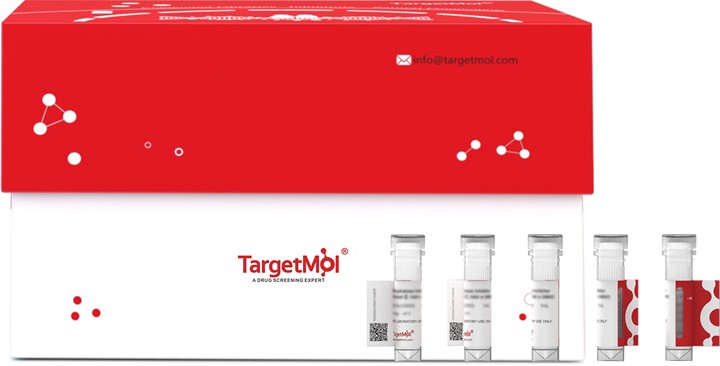 您的购物车当前为空
您的购物车当前为空
RAMP3 Protein, Human, Recombinant (hFc)
一键复制产品信息别名 receptor (G protein-coupled) activity modifying protein 3
RAMP3 belongs to the RAMP family. Members of this family are single-transmembrane-domain proteins, called receptor (calcitonin) activity modifying proteins (RAMPs). RAMPs have a wide biological distribution; high concentrations are found in the brain, lung, liver, heart and spleen with lower expression levels present in the testes, gastrointestinal tract and thyroid. RAMPs are type I transmembrane proteins with an extracellular N terminus and a cytoplasmic C terminus. They are required to transport calcitonin-receptor-like receptor (CRLR) to the plasma membrane. CRLR, a receptor with seven transmembrane domains, can function as either a calcitonin gene-related peptide (CGRP) receptor or an adrenomedullin receptor, depending on which members of the RAMP family are expressed. In the presence of RAMP3 protein, CRLR functions as an adrenomedullin receptor.


为众多的药物研发团队赋能,
让新药发现更简单!
RAMP3 Protein, Human, Recombinant (hFc)
一键复制产品信息RAMP3 belongs to the RAMP family. Members of this family are single-transmembrane-domain proteins, called receptor (calcitonin) activity modifying proteins (RAMPs). RAMPs have a wide biological distribution; high concentrations are found in the brain, lung, liver, heart and spleen with lower expression levels present in the testes, gastrointestinal tract and thyroid. RAMPs are type I transmembrane proteins with an extracellular N terminus and a cytoplasmic C terminus. They are required to transport calcitonin-receptor-like receptor (CRLR) to the plasma membrane. CRLR, a receptor with seven transmembrane domains, can function as either a calcitonin gene-related peptide (CGRP) receptor or an adrenomedullin receptor, depending on which members of the RAMP family are expressed. In the presence of RAMP3 protein, CRLR functions as an adrenomedullin receptor.
| 规格 | 价格 | 库存 | 数量 |
|---|---|---|---|
| 5 μg | ¥ 493 | 6-8日内发货 | |
| 10 μg | ¥ 790 | 6-8日内发货 | |
| 20 μg | ¥ 1,330 | 5日内发货 | |
| 50 μg | ¥ 2,580 | 5日内发货 | |
| 100 μg | ¥ 5,170 | 5日内发货 |
产品介绍
| 产品描述 | RAMP3 belongs to the RAMP family. Members of this family are single-transmembrane-domain proteins, called receptor (calcitonin) activity modifying proteins (RAMPs). RAMPs have a wide biological distribution; high concentrations are found in the brain, lung, liver, heart and spleen with lower expression levels present in the testes, gastrointestinal tract and thyroid. RAMPs are type I transmembrane proteins with an extracellular N terminus and a cytoplasmic C terminus. They are required to transport calcitonin-receptor-like receptor (CRLR) to the plasma membrane. CRLR, a receptor with seven transmembrane domains, can function as either a calcitonin gene-related peptide (CGRP) receptor or an adrenomedullin receptor, depending on which members of the RAMP family are expressed. In the presence of RAMP3 protein, CRLR functions as an adrenomedullin receptor. |
| 生物活性 | Activity testing is in progress. It is theoretically active, but we cannot guarantee it. If you require protein activity, we recommend choosing the eukaryotic expression version first. |
| 研究背景 | RAMP3 belongs to the RAMP family. Members of this family are single-transmembrane-domain proteins, called receptor (calcitonin) activity modifying proteins (RAMPs). RAMPs have a wide biological distribution; high concentrations are found in the brain, lung, liver, heart and spleen with lower expression levels present in the testes, gastrointestinal tract and thyroid. RAMPs are type I transmembrane proteins with an extracellular N terminus and a cytoplasmic C terminus. They are required to transport calcitonin-receptor-like receptor (CRLR) to the plasma membrane. CRLR, a receptor with seven transmembrane domains, can function as either a calcitonin gene-related peptide (CGRP) receptor or an adrenomedullin receptor, depending on which members of the RAMP family are expressed. In the presence of RAMP3 protein, CRLR functions as an adrenomedullin receptor. |
| 种属 | Human |
| 表达系统 | HEK293 Cells |
| 标签 | C-hFc |
| 蛋白编号 | AAH53852.1 |
| 蛋白构建 | A DNA sequence encoding the human RAMP3 (AAH53852.1) (Met1-Val118) was expressed with the Fc region of human IgG1 at the C-terminus. Predicted N terminal: Arg 24 |
| 蛋白纯度 | > 95 % as determined by SDS-PAGE |
| 蛋白性状 | Lyophilized powder |
| 缓冲液 | Lyophilized from a solution filtered through a 0.22 μm filter, containing PBS, pH 7.4. Typically, a mixture containing 5% to 8% trehalose, mannitol, and 0.01% Tween 80 is incorporated as a protective agent before lyophilization. |
| 复溶方法 | A Certificate of Analysis (CoA) containing reconstitution instructions is included with the products. Please refer to the CoA for detailed information. |
| 别名 | receptor (G protein-coupled) activity modifying protein 3 |
| 内毒素 | < 1.0 EU/μg of the protein as determined by the LAL method. |
| 分子量 | 37.8 kDa (predicted); 28-31 kDa (reducing conditions) |
| 运输方式 | In general, Lyophilized powders are shipping with blue ice. |
| 存储 | It is recommended to store recombinant proteins at -20°C to -80°C for future use. Lyophilized powders can be stably stored for over 12 months, while liquid products can be stored for 6-12 months at -80°C. For reconstituted protein solutions, the solution can be stored at -20°C to -80°C for at least 3 months. Please avoid multiple freeze-thaw cycles and store products in aliquots. |
计算器
剂量转换
对于不同动物的给药剂量换算,您也可以参考 更多





 还可以
还可以
 |
|